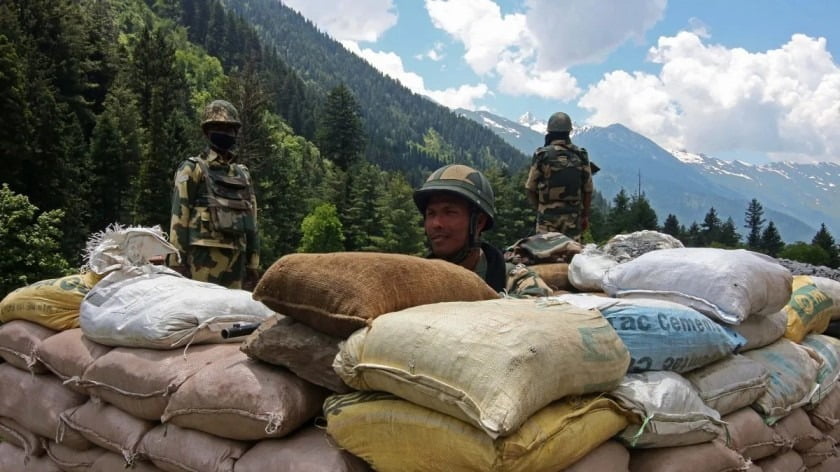1962 India-China War Redux?
Indian analysts have been comparing the military buildup on the India-China border in eastern Ladakh to the Doklam standoff in 2017. This was only to be expected, since the leitmotif is once again a road construction in disputed border regions.
In Doklam, India feared that the Chinese road would give its military access to heights from where it could threaten the Siliguri Corridor, India’s tenuous link with its northeastern regions.
In Ladakh, Indian analysts estimate, the Chinese military has positioned itself to challenge road construction by India that could threaten Aksai Chin and NH 219, the tenuous Xinjiang-Tibet highway.
Interestingly, China did not protest when India reopened the Daulat Beg Oldi airbase in 2008 after abandoning it during the 1962 war or even when the Indian Air Force built it up rapidly to such a scale that by 2013, one of its newly acquired Lockheed Martin C-130J-30 transport aircraft could land there.
Nor did China protest at any point through a two-decade period when the 255-kilometer Darbuk-Shyokh-Daulat Beg Oldi (DSDBO) all-weather road was completed. This is notwithstanding the fact that the DSDBO road cuts down the time taken for sending reinforcements or making forward deployments of troops and equipment from two days previously to just six hours – a game changer, so to speak.
Amid the tumultuous events in recent days in eastern Ladakh, India somehow lost sight of all this. Therefore, a primary question arises while making our assessments:
Why is China now all perked up when it was reconciled with the reopening of the Daulat Beg Oldie military base at the easternmost point of the Karakoram Range in a cold desert region in the far north of India, just 8km south of the Chinese border and just 9km northwest of the Aksai Chin Line of Actual Control (LAC) between the two countries, and just 10km from the Karakoram Pass that separates Tibet from Xinjiang?
The answer is, China no longer thinks that it can afford to take lightly the steady Indian buildup of military infrastructure in that region – known as Sub Sector North (SSN), which lies just to the east of Siachen glacier and is the only area that provides direct access to Aksai Chin from India.
Clearly, China does not want any threatening buildup of military infrastructure in the SSN. However, India has also begun constructing branch roads from the DSDBO in the northerly direction, which allows India to get behind the Chinese defenses via a number of spurs, known as “fingers,” coming down from the north.
Now, through the Indus Valley to the north of SSN on the Chinese side, runs the immensely strategic NH 219 highway and where the Chinese base with an airfield is located at Ngari. (To put things in perspective, Ngari is only 50km from Demchok, and here we have the terrain advantage; Ngari can also be threatened from Chumar.)
Historically, before the 1962 war, China thought it had secured all territories it needed for the security of the Tibet-Xinjiang NH 219 highway. In fact, after the 1962 war, when China unilaterally declared a ceasefire and vacated all additional captured territory, it also gave up control of the tactically important areas in Ladakh that could provide access to Aksai Chin and NH 219. But they have become hotspots now.
Suffice to say, the Chinese seem to think India has reoccupied those vacant spaces and are building sinews that enable the Indians to challenge the NH 219 highway if push comes to shove in bilateral relations. China has become highly suspicious of the Indian intentions.
Arguably, China has somehow come to believe that in the long term, India’s strategic aim is to restore the 1950’s status quo by recovering Aksai Chin and other areas secured by China prior to the 1962 war.
A former commander of the Indian Army’s Northern Command, retired Lieutenant-General H S Panag, wrote recently, “Much as I would like to speculate about China’s broader political aims, the direct political aim is simple – to maintain the ‘status quo’ along the LAC on its own terms, which is to forestall any threat, howsoever remote, to Aksai Chin and NH 219.”
NH 219 mountain road
How did this breakdown in trust happen? The roots lie in the era of the United Progressive Alliance government in India. In strategic terms, India’s “forward policy” in eastern Ladakh that began during the UPA rule can only be regarded as a template of the overall militarization of the country’s foreign policy, which accelerated during the 2010-2014 period.
This was a period, following the signing of the US-Indian nuclear accord in 2008, when the relationship between Washington and New Delhi underwent a historic transformation and the doctrine of “interoperability” with the US military surreptitiously began permeating the Indian strategic calculus. That process eventually turned into one of tying India down somehow in the American stable.
Conceivably, some among the Indian bureaucratic elite would have facilitated this happening at a time when the UPA leadership of Manmohan Singh was getting battered, distracted and hopelessly besieged, and domestic politics had entered a turbulent phase signifying the Congress party’s terminal sickness.
Be that as it may, India’s foreign policy became correlated to the alliance with the US, and a belief grew – which the present Indian government inherited – that a muscular approach toward China had become sustainable and that is the language China will come to fear, now that Sino-American tensions are also cascading.
On the other hand, given the ultra-nationalist fervor sweeping the country, sections of the Indian public also began believing our own rhetoric that the Indian military is today more than a match for China’s – that, in a conflict in the Himalayas, India can give a “bloody nose” to the Chinese military.
But such beliefs are delusional. China is a superpower. Although Indian military strength has increased in the recent decades, the fact remains that China has phenomenally modernized its armed forces with technologies that have a force multiplier effect that are way beyond India’s capability.
Nonetheless, delusional thinking is rampant in India, including among sections of the elite who ought to know better. This is further compounded by the “testiness” in India’s posturing toward China in the period since the Doklam standoff, which the establishment spin had touted as a victory, but experts increasingly debunked as a mere face-saving retreat.
Meanwhile, provocative moves such as the presence of the Tibetan government-in-exile in India; the aggressive claims on Pakistan-administered Kashmir and Gilgit Baltistan; talk of abandoning the “one China” policy; the dalliance with the US over the “Wuhan virus”; the challenge to the US$60 billion China-Pakistan Economic Corridor; and of course the overall lurch toward the “Quad” signaling an intention to bandwagon with the US containment strategy against China – all these were manifestations of such “testiness.”
They might have been intended as pinpricks, but they have contributed significantly to vitiate the climate of India-China relationship and create mutual suspicions.
However, the red line was breached when the Indian government followed up its decision last August on abrogating Article 370 of the constitution to change the status of Jammu and Kashmir by making a breathtaking territorial claim on Aksai Chin, enshrining the claim on a map, which in military terms could only imply from the Chinese perspective a strategic intention on India’s part to sever Tibet’s link with Xinjiang – nothing more, nothing less.
Indeed, while all these shenanigans were playing out, strategic communication was conspicuous by its total absence in the relationship during the period since “China Connect” in October last year.
Quite obviously, in light of all these major shifts in Indian policies, China began to read a new meaning into the feverish road-construction activities close to the LAC, the attempts to create feeder roads of the DSDBO leading to Aksai Chin and so on.
A cloud of suspicions has formed that is going to be extremely difficult to dispel in the near term. Unless India properly assesses China’s motivations, negotiations with that country will be meaningless.
Is it the case that China is seeking territorial expansion? If so, there is no scope for negotiations. But China insists it doesn’t want war with India, nor does India want war with it.
Is it that Chinese Communist Party leadership has become so weak because of the Covid-19 pandemic that it is punching India to flex its muscles? Ridiculous as this may seem, this question must be asked, because some of India’s top China hands do read the tea leaves this way.
Or, is China on a deliberate path to humiliate India? But then, to work on such a motivation, China has other non-military means instead of enacting a gruesome murderous scene in the Himalayas.
Is China conspiring with Pakistan to create a two-front war for India? For sure, there is no empirical evidence whatsoever in that direction.
What else could be in the Chinese calculus? Surprisingly, there is hardly any willingness in the Indian narratives to consider whether Beijing too might have its own security concerns over New Delhi’s long-term intentions.
An honest appraisal becomes difficult because it is entangled with the Indian government’s decision on Article 370, which is cast in iron and is apparently irrevocable, as it is linked to the ruling elite’s ideology – plus, India’s “pivot” to the US, which is at the core of New Delhi’s foreign policy. The ruling elites do not even want to talk about this after President Donald Trump presented his mediatory offer to bring about India-China reconciliation, signaling his neutrality and disinterest in getting dragged into the current standoff.
We do not realize that the Indian government’s words and actions are taken seriously by our neighbors – be it China or Nepal or Bangladesh. Perhaps we can convince Dhaka someday that we actually do not regard Bangladeshi nationals as “termites.”
But how can the Indian government possibly say to the Chinese that the claim to Aksai Chin is mere posturing for domestic consumption only and not to be taken seriously as a statement of policy when it was stated in all solemnity by senior figures in the government that they do intend to gain control of that region some day?
When China protested strongly over the August decision on J&K – not once but twice – India ignored it. And to compound matters, it simply turned its back and walked over to the “Quad” alliance with the US, upgrading it to ministerial level, and began following the American footfalls on Taiwan and Covid-19 to taunt and humiliate Beijing.
Most certainly, public opinion in India is furious over the cruel killing of so many Indian soldiers in Ladakh on June 15-16. Feelings are running high. There is loud clamor for “retaliation.” But unless there is public awareness of the eddies in India’s China policy, a rational response to the horrific incident is not going to be possible.
The buck stops with the Indian leadership. Whereas Indian nationalism should have been utilized to spur the country’s transformation as a middle-income country in a conceivable future and to eradicate the poverty affecting the lives of hundreds of millions of Indians, it has degenerated into jingoism and the stuff of grandstanding by the ruling elite.
What purpose the annulment of Article 370 achieved is debatable. But without doubt, it has damaged the India-China relationship.
By M.K. Bhadrakumar
Source: Asia Times







